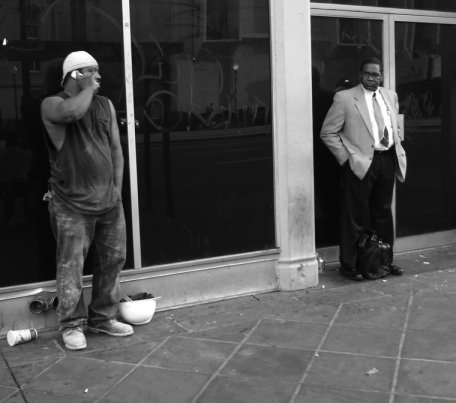|
Style and Class
Mark Mihaly* works at a service job, for just over $8 an hour. He might be a waiter, a baristo, a used bookstore clerk, or a production assistant. On good months, he has maybe $600 in his checking account at any one time. On bad months, he eats ramen and works overtime until he's ready to drop from exhaustion. Were he to get sick, he could not afford to stop working. Compare Mark to Jake Will*. A grocery bagger, fast food worker, dishwasher or video store clerk, Will makes the same hourly wage as Mark. Jake has moved in with his girlfriend and another roommate, which gives him some (but not much) latitude. He's also moved out of the expensive part of town, which makes his commute longer but decreases his rent. Reading the above descriptions, you might conclude that Mark and Jake have nearly identical life circumstances. In many ways, Mark and Jake are similar; if they live in the same city, they're likely to cross paths. Both are white males in their mid-twenties. Both have college-level intelligence. Both are in a form of prolonged adolescence and postponed adulthood. If and when these two cross paths, though, it's unlikely (though not impossible) they will strike a friendship or even really see each other. Why? The answer is simple: despite their similarities, Mark and Jake belong to different social classes. Chances are, both Mark and Jake think of themselves as middle class. Both probably imagine themselves getting rich before old age. But which one has more of a chance? They should have even odds, right? To answer that, take a brief look at their outfits. Let's start with Mark Mihaly. In the winter, Mark usually wears a black overcoat, gray or blue slacks, and a sweater over one (or more) button-up shirts. Sometimes he also wears a scarf. His glasses have thin, silver wire frames. In the winter Mark grows his facial hair, which he shaves off (except for some small sideburns) during the summer. At home and in the summer, he usually relaxes in a pair of jeans and a band t-shirt. He has four pairs of shoes: Pumas, ratty Converse or Keds, galoshes and leather dress shoes. Jake Will, in contrast, weathers out the winters in a hoodie or windbreaker. If he's in a really cold part of the country, he might add a puffy jacket. In the summer, he will usually wear an oversized band or sports t-shirt with a pair of faded blue jeans, sometimes with a baseball cap. Much of the time, however, he's in some kind of uniform, since his job requires it. He has three pairs of sneakers and a pair of rain boots. Ceteris paribus, which one projects more competence? Which one is more likely to put a potential employer at ease? Which one is more likely to be promoted? Which one appeals more to older, authority figures? Which one would you trust? Now let's look at Mark and Jake's family backgrounds. Mark's father is a psychiatrist, and his mother is a mathematics professor at a state university. They both have advanced degrees, and their parents (Mark's grandparents) both went to college, as well. Jake's parents, in contrast, Jake's father runs an auto repair shop, while his mother works as a secretary at a large law firm. Both have high school diplomas; his mother has an associate's degree, and his father has certifications for car repair and maintenance. Neither family is rich, or poor; they both probably consider themselves middle class. To a dispassionate observer, one is upper-middle class, the other lower-middle class. They have different friends, different prospects and different lifestyles. These differences stay with their children, even after they've reached adulthood. Neither Mark nor Jake pay much attention to their outfits. If they did, they might notice how strongly they conform to the uniforms of their respective social classes. Neither really notices how their respective dress styles affect their potential and their opportunities in life. Class is not just money, or your family's money. When people say something's "classy," they're unconsciously pointing out the distinction between money and class. Think about it. Britney Spears has millions, perhaps tens of millions, of dollars. Yet she's routinely photographed going out in an ill-fitting t-shirt and sweatpants, without a bra. It doesn't matter if she was a billionaire, a shirt without a bra is still not "classy." So what do style and class have to do with each other? The answer depends, to a large extent, on the culture and the class system you're asking about. In some cultures, each social class has an almost mandatory uniform. In others, certain details and tendencies give the game away. But, everywhere and always, style and class interact, usually as a sort of invisible gatekeeper to the privileges of the rich and/or the influential. Related Reading: 15 Ways to Clean Out Your Closet *Pseudonyms, altered from composites of real cases. Above photo by Ravi Grover, used under CC Attribution License. Style and class is part of our Style and... essay section. Return to Enjoy Your Style's home page. Not what you're looking for? Find it, below: |
Search this site:





